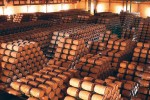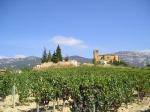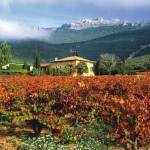After walking the Camino de Santiago I headed back to Rioja. I was ready for a good glass of wine.
I may have walked 850km across Spain got to Santiago de Compostelle but I wasn’t done yet as when I passed through Rioja I hadn’t done any serious wine tasting there. As this woman does not live on bread alone, this was remiss of me. So I retraced my steps, (on a coach this time) back to Logroño, the regional capital of Rioja, so I could visit some wineries.
When I’d been in Logroño three weeks earlier walking the camino, the whole town had been crawling with pilgrims and as there was no room in the hostel, I, and around 50 other people, ended up sleeping on the floor of a parish building. I was exhausted and was simply grateful for a roof over my head, in the morning I happily donated a few euros to the church fund. But this time it was different I was a guest of the Rioja Consejo and they were treating me to the 4 star Hotel Carlton. I had a room with a proper bed all to myself and, oh halleluiah, an en suite bathroom. This was a reversal of fortune.
I was also aiming high with the wineries I visited. I’d had some pretty basic food and wine on the pilgrim trail; I needed some gastronomic pampering.
Faustino

My first trip was to Faustino. Faustino Rioja can seem rather ubiquitous, in Britain Faustino VII is a safe bet if you have to run into the corner shop for emergency rations, but I was not in the mood for the common place so I was delighted when my host brought out a bottle of Faustino I, 1996, Gran Reserva for me to taste.
The company has gone to some lengths to make this wine look high brow: heavy bottle, frosted glass, wire mesh and a portrait of a wily looking Dutch burgher on the label which I discovered was painted by Rembrandt, no less.
The wine itself is everything you want from a top end Rioja: leather, tobacco and cherry aromas and a full flavoured palate with subtle tannins and a smooth long finish. Delicious.
Salceda

At Salceda I met Nuria Lagunilla and we had a leisurely lunch looking out of the window at a view that made me wonder I didn’t just stay in Spain forever: the vineyards rolled away to the distant mountains and above us the sky was a perfect blue,what’s more the lunch was elegant and delicious. I’d had some pretty rough cooking on the camino so I really relished these dishes. They were made from the same ingredients: christoria or spicy sausage, tuna with tomato sauce and roast rack of lamb with peppers, but we were a world away from the 9€ menu peregrino.
The wine we shared was a Conde Salceda 2001. It has the soft garnet hues of a mature wine and was something of a treat for a grown-up chocoholic. It was very fresh, very elegant very gentle and very juicy. Perfect.
Bodega LAN.
Wood ageing in Rioja is a big part of the wine style, so much so that wines are classified by the amount of time they spend in barrel. Crianza: twelve months in oak and six months in bottle; Reserva: twelve months in oak and two years in bottle and Gran Reserva two years in oak and three years in bottle.
 Small wonder then that Bodega LAN takes wood very, very seriously and has built a huge barrel room which they describe as a ‘cathedral to wood’. As I’d seen quite a few cathedrals on my pilgrimage, culminating in the Barroque exuberance that is the Cathedral in Santiago de Compostela, I initially thought Lan’s description was self-aggrandising but when I walked into the huge, vaulted, sweet smelling chamber, stacked high with barrels, and felt the room’s quiet atmosphere, I decided it was appropriate.
Small wonder then that Bodega LAN takes wood very, very seriously and has built a huge barrel room which they describe as a ‘cathedral to wood’. As I’d seen quite a few cathedrals on my pilgrimage, culminating in the Barroque exuberance that is the Cathedral in Santiago de Compostela, I initially thought Lan’s description was self-aggrandising but when I walked into the huge, vaulted, sweet smelling chamber, stacked high with barrels, and felt the room’s quiet atmosphere, I decided it was appropriate.
However all of this emphasis on wood did make me nervous for the tasting, I’ve had Rioja’s in the past which taste like a hit over the head with a 2 by 4 but Bodegas Lan Gran Reserva 2003 was not what I feared. The wood flavours had become very, very integrated and but still brought some terrific spicy notes to the wine, along with the fruit flavours this was as satisfying as a hunk of Dundee cake.
Remirez de Ganuza
 Bodega Remirez de Ganuza is in the village of Samaniego in Rioja Alavesa. Samaniego is just a small cluster of houses round an early Medieval church. Somebody drives by on a tractor, a black cat crosses my path. This is not a place where you expect to find radical ideas but Remirez de Ganuza has reinvented winemaking to such an extent that they have patented some of their techniques.
Bodega Remirez de Ganuza is in the village of Samaniego in Rioja Alavesa. Samaniego is just a small cluster of houses round an early Medieval church. Somebody drives by on a tractor, a black cat crosses my path. This is not a place where you expect to find radical ideas but Remirez de Ganuza has reinvented winemaking to such an extent that they have patented some of their techniques.
Points of difference start in the vineyard when bunches of Tempranillo grapes are picked, the ‘shoulders’ of the bunches are used for the top quality wines and the base are used for rest. But the clever engineering can be seen in the vats where instead of using a normal press a balloon is inserted into the tank which is filled with water, this slowly presses the wine so there is very little contact with oxygen.
The fruits of this apogee of pressing can be tasted in Remirez de Ganuza, Trasnocho 2005. It has a meaty nose with lots of dark fruit flavours, smoke and liquorice notes. The palate has lots of dark flavours which are complimented by a fresh note. It is an intense experience.
However the wine I’d prefer to put on my dining table is the Fincas de Ganuza Reserve 2003. It is light and elegant with lots of fruit flavours and an integrated oak flavour which gives the wine an attractive savoury balance and is a pleasure to drink.
Remelluri
It’s a climb up a rough track into the Sierra de Cantabria mountains to get to Remelluri, but it is worth it as this has to be one of the most beautiful bodega in Rioja. It describes itself as being a ‘château’ winery meaning that all the vineyards are owned by the company and grouped around the winery. In the fourteenth century the estate was owned by the Monastery of Toloño, this building is long gone but a sanctuary high above on the Toloño summit still exists.

From the winery to the outlying vines it is a further climb, luckily MD Jose Maria Nieves Nuin can handle a Land Rover. Unusually for the region Remelluri has a selection of white grapes (Roussanne, Marsanne, Viognier, Chardonnay, Sauvignon Blanc, Petit Courbu, Granache Blanc and Muscat des Petits Grains) which make a delicious white Rioja. The 2006 has a lovely glycerol texture like olive oil and, like a Golden Age still life in a well-chosen frame, the fruit flavours are off set by a background of wood.
But this is Rioja and red wines are king, and the crown of Remelluri is is La Granja Remelluri Gran Reserva 1999, which is only made in exceptional years. This is an old fashioned wine which has had some deliberate oxidative ageing that brings some eucalyptus and rosemary aromas to the nose and elegant tobacco and liquorice flavour to the palate.
Ramón Bilbao
This was my last stop before I left Spain. There were two wines that particularly caught my attention here the first being Ramón Bilbao Mirto 2005. Paula Zúñiga, marketing manager, described the wine as being the ‘Formula 1 of the range’. It is made from 70 year old vines, although it comes under the Rioja DOC umbrella it does not fit into a Reserva or Gran Reserva category, making it something of a modern maverick.
On the nose Mirto is fabulously intense, meaty and smoky with a back note of dark damson fruit. The palate is gentle with quite dusty tannins and chocolate, damson and spice notes. Modern and fruity this wine remains firmly Spanish.
 Appropriately one of my last wines in Spain was not from Rioja but from Galicia, where my pilgrimage ended. It is made by Mar de Frades, a sister company to Ramón Bilbao. There is a lovely story that alleges that Albariño is the same as Riesling and was brought to Galicia by monks travelling from the Rhine to Santiago de Compostela. Science has proved this not to be the case, (once again spoiling a good story!) but Mar de Frades, Albariño has a zingy, salty quality that reminds me of the sea at Finisterre. It is fitting that the last stop on my Rioja wine tour reminds me of my last stop on the Way of Saint James.
Appropriately one of my last wines in Spain was not from Rioja but from Galicia, where my pilgrimage ended. It is made by Mar de Frades, a sister company to Ramón Bilbao. There is a lovely story that alleges that Albariño is the same as Riesling and was brought to Galicia by monks travelling from the Rhine to Santiago de Compostela. Science has proved this not to be the case, (once again spoiling a good story!) but Mar de Frades, Albariño has a zingy, salty quality that reminds me of the sea at Finisterre. It is fitting that the last stop on my Rioja wine tour reminds me of my last stop on the Way of Saint James.
When I leave the hotel in Logroño some businessmen spot my backpack and scallop shell, the sign of the pilgrim, and shake my hand and wish me well. I know this is the last time that this will happen, I’m about to go back to being a normal citizen, I will no longer be a pilgrim, I have a pang of regret but the stay in Rioja has reminded me of the things that I’ve been missing: fine wine, good food and hot baths. I was ready to go home.
